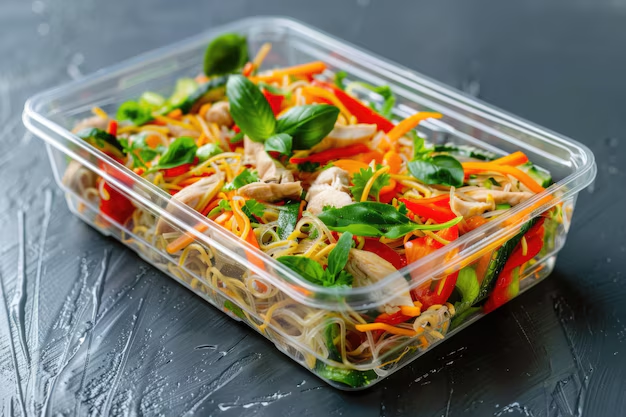How to Store Coleslaw: Maximizing Freshness in Your Refrigerator
Coleslaw: crunchy, tangy, and a staple side dish at barbecues and picnics. But once the party's over, how long will this creamy delight keep in your refrigerator? Fear not, as we dive into this essential question, exploring everything you need to know about extending coleslaw’s shelf life and ensuring it stays fresh and safe to eat.
Understanding Coleslaw’s Shelf Life
The Basics of Coleslaw Preservation
Coleslaw, a salad made primarily of cabbage and often dressed with mayonnaise or a vinaigrette, is beloved for its crunchy texture and refreshing taste. However, its perishability is an issue many contend with. Typically, homemade coleslaw lasts about three to five days in the refrigerator if stored properly. Pre-packaged coleslaw from stores, due to preservatives, might last a little longer, usually until the expiration date on the packaging. However, once opened, it should also be consumed within that same three to five-day window.
Factors Affecting Freshness
Several factors can influence how long coleslaw stays fresh:
- Ingredients Used: The type of dressing—whether mayonnaise or vinegar-based—affects longevity. Vinegar-based coleslaws are a bit more acidic and may keep slightly longer.
- Temperature: Consistent refrigeration at temperatures below 40°F (4°C) is critical to prevent bacterial growth.
- Storage Conditions: Airtight containers will help prevent contamination and absorb odors that could alter the taste and integrity of the coleslaw.
Proper Storage Techniques
Packaging and Containers
When it comes to keeping coleslaw fresh, proper packaging is key. Here’s how to do it right:
- Use airtight containers to minimize air exposure and reduce the growth of bacteria.
- If using plastic wrap, ensure that it completely covers the surface of the coleslaw to limit exposure to air.
- Store containers in the coldest part of your refrigerator, usually towards the back, to maintain consistent temperature levels.
First In, First Out
A practical tip for managing coleslaw in your fridge—use the First In, First Out (FIFO) method. This means consuming older batches of coleslaw first before diving into a newly made or purchased batch. This strategy helps prevent keeping food long past its prime.
Signs Your Coleslaw Has Gone Bad
Keeping an eye out for signs of spoilage is important to prevent consuming bad coleslaw. Here are common indicators that it might be time to toss it:
- Smell: A sour or rancid odor can signal bacterial growth.
- Texture: Sliminess or excessive wilting indicates spoilage.
- Appearance: Discoloration such as black or brown spots suggest mold or bacterial infestation.
If any of these signs are present, it’s best to discard the coleslaw to avoid potential foodborne illnesses.
Extending Coleslaw’s Shelf Life
Homemade Techniques for Longevity
There are several methods you can employ to extend the life of your homemade coleslaw:
- Acidity Addition: Adding extra vinegar or lemon juice can increase acidity, slowing spoilage.
- Portion Control: Serve smaller portions to avoid contamination from utensils used by multiple people.
Freezing: Is It an Option?
While freezing extends the shelf life of many foods, coleslaw is an exception that often doesn't fare well due to its high water content. Freezing may cause the cabbage to become limp and the dressing to separate. However, if you decide to proceed, consider these tips:
- Freeze a vinegar-based coleslaw rather than one with mayonnaise.
- Blanch the cabbage before freezing to maintain some crispness once thawed.
- Make sure it’s in an airtight, freezer-safe container to prevent freezer burn.
Related Subtopics: Sauerkraut and Kimchi
To provide further context, let's briefly explore similar cabbage-based dishes like sauerkraut and kimchi, which utilize fermentation, a different preservation method that inherently extends shelf life.
Sauerkraut
Sauerkraut is fermented cabbage with a tangy taste, known for its long shelf life due to its natural probiotics. When refrigerated in an airtight container after opening, sauerkraut can last several months, making it a great alternative if you're seeking cabbage with longer shelf stability.
Kimchi
Kimchi, a staple in Korean cuisine, is another type of preserved vegetable dish that includes cabbage and can last an extended period due to its fermentation process. Like sauerkraut, kimchi can remain fresh for months when stored properly in a refrigerator, adding a spicy twist to your meals.
Quick Reference Guide: Coleslaw Storage Tips
To enhance your food storage practices, here's a handy checklist on keeping coleslaw fresh:
- 🥗 Use airtight containers for storage.
- ❄️ Refrigerate below 40°F (4°C) consistently.
- ⏳ Consume within three to five days for optimal freshness.
- 👃 Discard if smell, texture, or color changes.
- 🥒 Consider vinegar-based dressings for longer shelf life.
Final Insight: Embracing Proper Storage Practices
Understanding how to store coleslaw can greatly increase its longevity and ensure its quality. By implementing these proper storage techniques and recognizing signs of spoilage, you can enjoy this delicious side dish safely and to its fullest potential. Additionally, exploring fermented alternatives like sauerkraut and kimchi could offer exciting culinary variations that last longer in your refrigerator.
By adhering to these guidelines, you'll not only reduce food waste but also enhance your refrigerator management skills, making every bite of coleslaw as tasty as the last.
